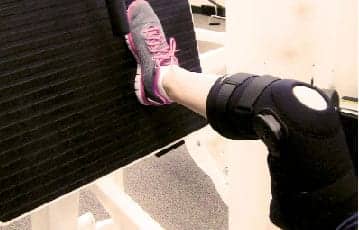 |
Choosing the right brace for an adult or child with a problem knee can be a challenge, if for no other reason than the sheer array of products available. But yoke the dilemma of selection to the fact that a wide variety of symptoms and pathologies are possible at this one joint, and it becomes plain why many therapists end up trying their clients in a number of braces before finally hitting upon the one that works best in each individual’s case.
However, recent research suggests another variable in all this: the interconnectedness of the knee with both nearby and distant anatomical structures. “There is, for example, a growing understanding and appreciation of the relationship between the knee and the hip,” says Chad L. Crossley, DPT, ATC, Physical Therapy Orthopedics Resident, University of Pittsburgh Medical Center/Centers for Rehab Services, who points to the work in this field emerging from the University of Southern California. ” Dr Christopher Powers there has been researching the role of the hip in regard to patellar malalignment. The premise of his investigations is that the hip controls a lot of what happens at the knee.”
Kate J. Grace, PT, OPA-C, owner of Kate Grace Physical Therapy in San Diego, concurs with the notion that knee mechanics are linked to those elsewhere in the body. She suggests that seeing knee problems in this light leads therapists to think more systematically about bracing. Adapting a systematic approach puts clinicians “in a position to actually solve musculoskeletal problems rather than simply minimize symptoms,” Grace says.
KNOW THE PROBLEM
But before a problem can be solved, one must first identify it. Accordingly, the starting point in use of systemized knee bracing is a thorough evaluation, Grace advises.
|
“The goal of a knee evaluation is not to figure out where the pain is—the patient can tell you that,” she says. “The goal is to figure out the cause. Once you do that, you’re better able to solve the problem—and permanently, not just for today.”
Patellofemoral dysfunction (PFD) is perhaps the world’s most common orthopedic problem, with one in four people expected to develop it at some time in their life, Grace indicates. However, she adds, PFD is far from the only disorder a clinician is likely to encounter at the knee.
“There also is knee osteoarthritis,” Grace recounts. “With an older knee osteoarthritis patient, as many as three of the compartments of that joint might be involved. The goal should be to buy this patient as much time as you can before a total knee replacement is unavoidably necessary. To do this, you’ll need to identify anything that’s putting abnormal pressure on that knee.” Three possible sources of that pressure might be patella or compartment malalignment, inflexibilities, or weaknesses, she offers.
Another common problem that presents with symptoms at the knee is the torn anterior cruciate ligament. “The patient might be someone with an ACL reconstruction or maybe just a partially torn ACL,” says Grace. “Either way, the goal is to stop the tibia from gliding on the femur. That will be the job of the brace. But more than that, this individual will require highly developed and aggressive therapy to utilize the secondary restraints in the knee so as to maximize stability.” Grace explains that this is in part what she means by taking a systematic approach to knee bracing.
AROUND THE BEND
Even if one wishes to employ systematic thinking, at the core of it all there is still the knee brace itself. Virtually all knee braces can be categorized as belonging to either the tibiofemoral or patellofemoral variety, Crossley reports. Subtypes in the tibiofemoral group are rehabilitation braces, prophylactic braces, functional braces, and unloading braces.
“Rehabilitation braces are used postoperatively to maintain knee alignment,” he says. “Flexion and extension can be controlled, and varus or valgus stress can be prevented.
“Prophylactic bracing historically was used to prevent or decrease the amount of injury during high-stress or contact sports. They are not used as much today, as there is mixed evidence regarding their effectiveness.
“Evidence is also mixed for functional braces, which are used to provide the patient with stability during functional activities,” Crossley says. The proposed benefits include improved patient proprioception, knee stability, and motor control. Functional braces are used extensively on post-ACL reconstruction patients. These also can serve as something of a security blanket for the athlete who fears reinjury—a fear that is usually always present. Wearing the brace gives them increased confidence.”
Medial knee pain is common in the osteoarthritis patient, so an attempt to unload the medial compartment is made with the use of an unloader brace, according to Crossley. The big problem with unloader braces is that they tend to be cumbersome and uncomfortable. Compliance suffers as a result, he says.
APTA ENDORSEMENT
The other major category of knee bracing—patellofemoral—encompasses infrapatellar straps, neoprene sleeves, realignment braces, and SERF straps.
“The infrapatellar strap applies pressure to the patellar tendon and is generally used for patellofemoral pain,” says Crossley. “It has also been suggested that it may alter blood supply, but there does not appear to be consensus on the beneficial mechanism.
“Neoprene sleeves are meant to alter compressive forces on the patella, but they do not change patellar alignment. The warmth of the knee is thought to be sufficiently increased by wearing a neoprene sleeve to alter sensory input, thereby further improving the patient’s comfort. Evidence for all of this is weak.
“Meanwhile, the idea behind the realignment brace is to affect faulty patellar tracking patterns. The research is mixed with no clear consensus.”
SERF stands for Stability thru External Rotation of the Femur, a name believed to have originated with its designer—USC’s Powers. Crossley notes that the SERF strap is intended to control movement at the level of the femur to prevent medial-lateral forces that may cause patellofemoral pain at the knee.
Among the relatively few patellofemoral braces to have earned endorsement from the American Physical Therapy Association is one designed by Grace and marketed under the name OnTrack. “It’s specifically for PFD and in particular for people who have pain in and around the kneecap, subluxing patellas, dislocating patellas, or all three in combination,” says Grace. “We created this product because there was nothing available to address the question of how to induce enough change in the bony anatomy of the patella to alleviate pain and strengthen the leg so that the patient can continue engaging in desired activities.”
TO EACH ACCORDING TO HIS KNEED
Regardless of the type of knee bracing used, the device will almost certainly prove ineffective if the patient has no clue how to use it.
“Education is an important component of knee bracing because, without it, compliance is difficult to achieve—and, without compliance, success can be elusive,” says Crossley. “Most patients won’t know how to use the brace or even how to correctly put it on and take it off unless they’re properly and adequately educated. Improper brace usage may place the patient at risk of further injury to the knee.”
Crossley asserts that education can be simple and sweet. “The main thing is to provide a basic understanding of the brace and its usage and the importance of compliance.”
That is precisely what Grace attempts with the education kit she provides to users of her PFD brace. “It consists of a patient-education DVD that explains patellofemoral dysfunction and demonstrates 13 different strengthening exercises for use at home,” she says.
A properly educated patient is one who will get the most benefit out of knee brace usage. But a therapist properly educated about the choices in knee bracing is one who sets the stage for that patient to experience a good result.
Rich Smith is a contributing writer for Rehab Management. For more information, contact .
Protecting the Patella
It was while working with very young children some years ago that Kate J. Grace, PT, OPA-C, began considering ways to change patella anatomy in adults suffering from patellofemoral dysfunction (PFD).
“Effecting a change in patella anatomy is key with PFD patients because the majority of them have bony malalignments,” Grace insists. “Attempts to strengthen the leg without first changing the anatomy are ineffective because this does nothing to change the patella position. In the course of exercising PFD kids, I would simply move their patella over and hold it where it was supposed to be. That technique works fine with small children because of their size. But with full-grown adults, not so much. It’s just not feasible to follow them around with your hand on their kneecap while they walk about.”
|
Visit Grace’s Web site at www.ontrackbrace.com for more information. |
The solution she eventually seized upon was a multipart knee brace that she has dubbed “OnTrack.” “It’s intended to fix the problem of PFD and to do so by nonsurgically changing the patella anatomy,” says Grace, now the owner of Kate Grace Physical Therapy in San Diego and active in the American Physical Therapy Association.
The brace works in part by increasing the contact area, that is, the surface area of the kneecap on the femur. This, Grace explains, relieves joint stresses, which, in turn, promotes a decrease in patellofemoral pains. “When you have a patella that’s malaligned, you have a very small contact area; therefore, the patient experiences increased joint stress and increased pain,” she says. “Taping is a good technique, but it’s for soft-tissue problems and it’s useful if your goal is to unload the patella tendon or change the soft tissue.”
Grace characterizes OnTrack as a system that includes not just a device but also a comprehensive evaluation of the knee, a physical therapy regimen, and a healthy dose of patient education.
“The goal in the evaluation stage is to identify patella malalignments,” she says. “Next, the brace must be properly applied in order to correct those identified malalignments. Afterward, manual therapy techniques must be performed in order to change the structures around the knee, followed by a very solid strengthening program that addresses everything in the musculoskeletal system, from head to feet—by that, I mean core strengthening, hip strengthening, and correction of postural and foot malalignments.”
The brace itself is constructed first of a patch consisting of two types of merged tape and a hook-and-loop securing system. This is placed directly over the kneecap. A neoprene sleeve—the second component—is pulled over the tape patch. A hole in the middle of the sleeve exposes the hook-and-loop so that it can grab the third piece of the brace—a bifurcated strap applied to the patella and pulled in the direction of the correction that needs to be made (this, says Grace, is the reason a good evaluation is so essential to success with this brace). Fourth, there is an applicator that provides stimulation and activation of weakened quadriceps.
—RS





